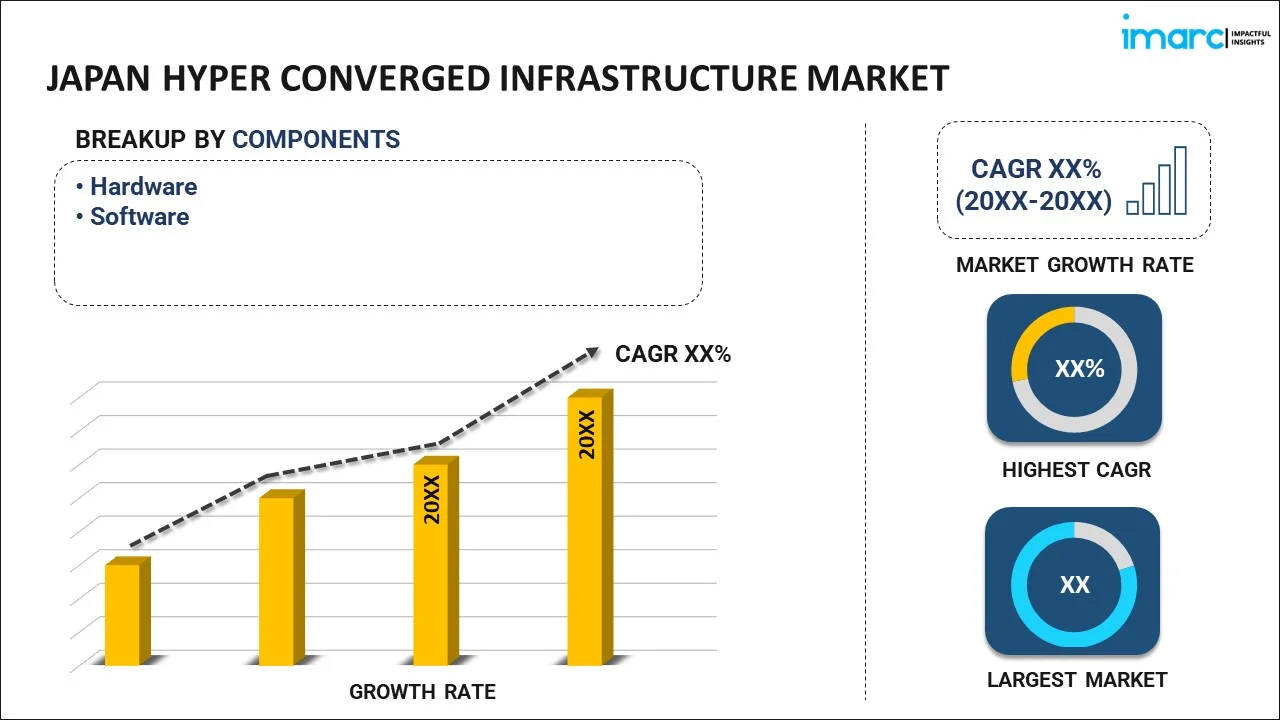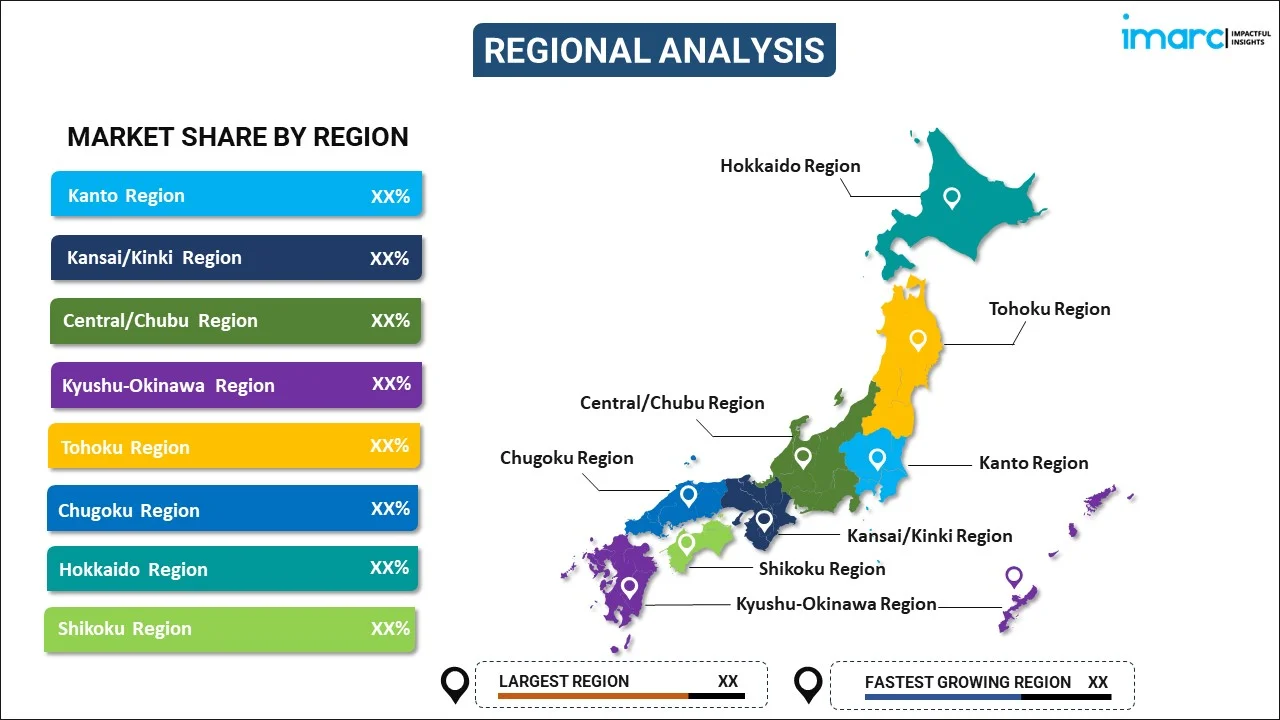
Japan Hyper Converged Infrastructure Market Report by Component (Hardware, Software), Application (Remote Office or Branch Office, Virtualization Desktop Infrastructure (VDI), Data Center Consolidation, Backup Recovery/Disaster Recovery, Critical Applications Virtualization, and Others), End Use (BFSI, IT and Telecommunications, Government, Healthcare, Manufacturing, Energy and Utilities, Education, and Others), and Region 2025-2033
Market Overview:
Japan hyper converged infrastructure market size reached USD 834.0 Million in 2024. Looking forward, IMARC Group expects the market to reach USD 4,745.0 Million by 2033, exhibiting a growth rate (CAGR) of 20.6% during 2025-2033. The increasing demand for automation and orchestration capabilities, which help to streamline routine tasks, reduce manual intervention, and improve efficiency, is driving the market.
|
Report Attribute
|
Key Statistics
|
|---|---|
|
Base Year
|
2024 |
|
Forecast Years
|
2025-2033
|
|
Historical Years
|
2019-2024
|
| Market Size in 2024 | USD 834.0 Million |
| Market Forecast in 2033 | USD 4,745.0 Million |
| Market Growth Rate (2025-2033) | 20.6% |
Hyper converged infrastructure (HCI) is a cutting-edge approach to data center management that consolidates and streamlines IT resources. It combines compute, storage, networking, and virtualization into a single, integrated solution. Unlike traditional data center architectures, which often involve separate silos for these components, HCI brings them together in a software-defined environment. HCI leverages software-defined storage to pool and manage data across the infrastructure, offering greater flexibility and scalability. This means that organizations can easily scale their resources by adding more HCI nodes, making it a highly adaptable solution for growing businesses. One of the key benefits of HCI is its simplified management. With a unified interface, administrators can efficiently oversee all aspects of the infrastructure, reducing complexity and improving overall operational efficiency. This integrated approach also enhances data redundancy and disaster recovery capabilities. Overall, HCI empowers organizations to streamline their data center operations, reduce hardware costs, and respond more quickly to changing IT demands, making it an increasingly popular choice for modern businesses seeking to optimize their IT infrastructure.
Japan Hyper Converged Infrastructure Market Trends:
The hyper converged infrastructure market in Japan has witnessed remarkable growth in recent years, primarily due to several key drivers. Firstly, organizations are increasingly seeking ways to streamline their IT operations and reduce infrastructure complexity. Consequently, HCI offers an all-in-one solution that combines computing, storage, and networking resources into a single integrated platform. This consolidation minimizes hardware sprawl and simplifies management, thereby reducing operational overhead. Moreover, the escalating demand for scalable and agile infrastructure aligns perfectly with HCI's capabilities. As businesses strive to accommodate evolving workloads and applications, HCI's ability to easily scale resources up or down provides a competitive edge. This scalability ensures that organizations can adapt to changing requirements without major capital investments. Furthermore, the rise of data-intensive workloads, such as big data analytics and artificial intelligence, has fueled the HCI market. HCI's ability to deliver high-performance computing and storage in a compact footprint is particularly attractive for businesses dealing with data-intensive tasks. In addition to this, the escalating need for enhanced data protection and disaster recovery capabilities to minimize downtime and ensure business continuity is expected to drive the hyper converged infrastructure market in Japan.
Japan Hyper Converged Infrastructure Market Segmentation:
IMARC Group provides an analysis of the key trends in each segment of the market, along with forecasts at the country level for 2025-2033. Our report has categorized the market based on component, application, and end use.
Component Insights:

- Hardware
- Software
The report has provided a detailed breakup and analysis of the market based on the component. This includes hardware and software.
Application Insights:
- Remote Office or Branch Office
- Virtualization Desktop Infrastructure (VDI)
- Data Center Consolidation
- Backup Recovery/Disaster Recovery
- Critical Applications Virtualization
- Others
A detailed breakup and analysis of the market based on the application have also been provided in the report. This includes remote office or branch office, virtualization desktop infrastructure (VDI), data center consolidation, backup recovery/disaster recovery, critical applications virtualization, and others.
End Use Insights:
- BFSI
- IT and Telecommunications
- Government
- Healthcare
- Manufacturing
- Energy and Utilities
- Education
- Others
The report has provided a detailed breakup and analysis of the market based on the end use. This includes BFSI, IT and telecommunications, government, healthcare, manufacturing, energy and utilities, education, and others.
Regional Insights:

- Kanto Region
- Kansai/Kinki Region
- Central/ Chubu Region
- Kyushu-Okinawa Region
- Tohoku Region
- Chugoku Region
- Hokkaido Region
- Shikoku Region
The report has also provided a comprehensive analysis of all the major regional markets, which include Kanto Region, Kansai/Kinki Region, Central/ Chubu Region, Kyushu-Okinawa Region, Tohoku Region, Chugoku Region, Hokkaido Region, and Shikoku Region.
Competitive Landscape:
The market research report has also provided a comprehensive analysis of the competitive landscape. Competitive analysis such as market structure, key player positioning, top winning strategies, competitive dashboard, and company evaluation quadrant has been covered in the report. Also, detailed profiles of all major companies have been provided.
Japan Hyper Converged Infrastructure Market Report Coverage:
| Report Features | Details |
|---|---|
| Base Year of the Analysis | 2024 |
| Historical Period | 2019-2024 |
| Forecast Period | 2025-2033 |
| Units | Million USD |
| Scope of the Report | Exploration of Historical Trends and Market Outlook, Industry Catalysts and Challenges, Segment-Wise Historical and Future Market Assessment:
|
| Components Covered | Hardware, Software |
| Applications Covered | Remote Office or Branch Office, Virtualization Desktop Infrastructure (VDI), Data Center Consolidation, Backup Recovery/Disaster Recovery, Critical Applications Virtualization, Others |
| End Uses Covered | BFSI, IT and Telecommunications, Government, Healthcare, Manufacturing, Energy and Utilities, Education, Others |
| Regions Covered | Kanto Region, Kansai/Kinki Region, Central/ Chubu Region, Kyushu-Okinawa Region, Tohoku Region, Chugoku Region, Hokkaido Region, Shikoku Region |
| Customization Scope | 10% Free Customization |
| Post-Sale Analyst Support | 10-12 Weeks |
| Delivery Format | PDF and Excel through Email (We can also provide the editable version of the report in PPT/Word format on special request) |
Key Questions Answered in This Report:
- How has the Japan hyper converged infrastructure market performed so far and how will it perform in the coming years?
- What has been the impact of COVID-19 on the Japan hyper converged infrastructure market?
- What is the breakup of the Japan hyper converged infrastructure market on the basis of component?
- What is the breakup of the Japan hyper converged infrastructure market on the basis of application?
- What is the breakup of the Japan hyper converged infrastructure market on the basis of end use?
- What are the various stages in the value chain of the Japan hyper converged infrastructure market?
- What are the key driving factors and challenges in the Japan hyper converged infrastructure?
- What is the structure of the Japan hyper converged infrastructure market and who are the key players?
- What is the degree of competition in the Japan hyper converged infrastructure market?
Key Benefits for Stakeholders:
- IMARC’s industry report offers a comprehensive quantitative analysis of various market segments, historical and current market trends, market forecasts, and dynamics of the Japan hyper converged infrastructure market from 2019-2033.
- The research report provides the latest information on the market drivers, challenges, and opportunities in the Japan hyper converged infrastructure market.
- Porter's five forces analysis assist stakeholders in assessing the impact of new entrants, competitive rivalry, supplier power, buyer power, and the threat of substitution. It helps stakeholders to analyze the level of competition within the Japan hyper converged infrastructure industry and its attractiveness.
- Competitive landscape allows stakeholders to understand their competitive environment and provides an insight into the current positions of key players in the market.
Need more help?
- Speak to our experienced analysts for insights on the current market scenarios.
- Include additional segments and countries to customize the report as per your requirement.
- Gain an unparalleled competitive advantage in your domain by understanding how to utilize the report and positively impacting your operations and revenue.
- For further assistance, please connect with our analysts.
 Inquire Before Buying
Inquire Before Buying
 Speak to an Analyst
Speak to an Analyst
 Request Brochure
Request Brochure
 Request Customization
Request Customization




.webp)




.webp)












